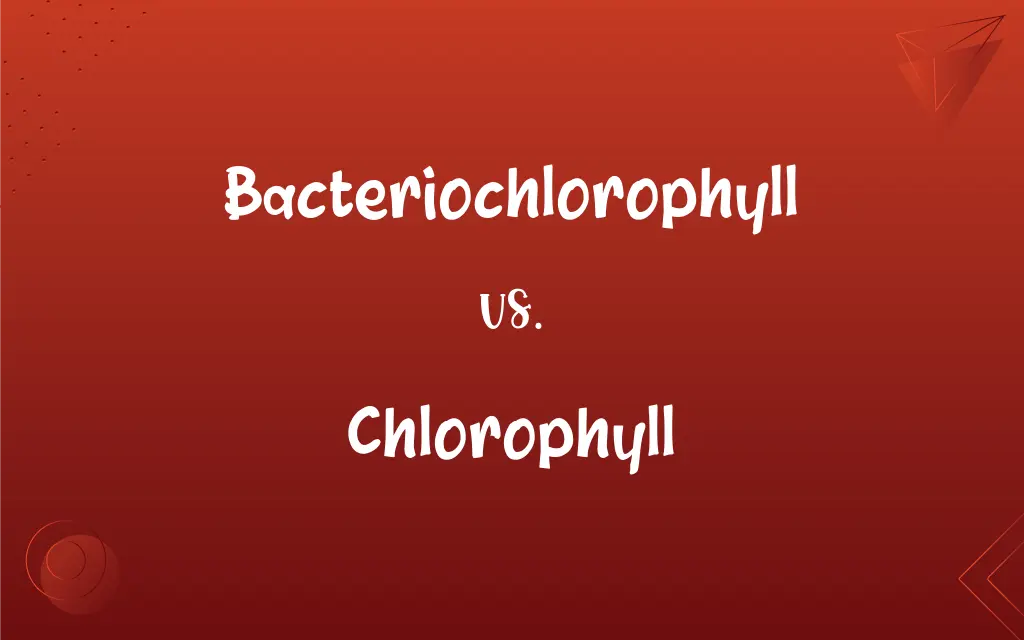Bacteriochlorophyll vs. Chlorophyll: What's the Difference?
Edited by Aimie Carlson || By Janet White || Published on February 27, 2024
Bacteriochlorophyll is a photosynthetic pigment found in certain bacteria, absorbing light in a different spectrum than chlorophyll, which is the primary pigment in plants and algae.

Key Differences
Bacteriochlorophyll and chlorophyll are both photosynthetic pigments, but bacteriochlorophyll is found in photosynthetic bacteria, while chlorophyll is prevalent in plants and algae. This distinction is crucial for their respective roles in photosynthesis.
The absorption spectrum of bacteriochlorophyll is different from that of chlorophyll, allowing bacteria to photosynthesize in less illuminated and different spectral environments. Chlorophyll primarily absorbs red and blue light, optimizing it for terrestrial light conditions.
Bacteriochlorophyll enables certain bacteria to perform photosynthesis under low-light conditions, often in aquatic environments. In contrast, chlorophyll is adapted for higher light conditions typically found in terrestrial habitats.
The chemical structure of bacteriochlorophyll differs slightly from chlorophyll, leading to its unique absorption properties. Chlorophyll has a structure that is more conducive to capturing light in brighter, more direct sunlight.
Both bacteriochlorophyll and chlorophyll are vital for capturing light energy, but their efficiency and function vary according to the organisms they are found in and the environmental conditions they are adapted to.
ADVERTISEMENT
Comparison Chart
Found in
Photosynthetic bacteria
Plants and algae
Light Absorption Spectrum
Different spectrum, adapted for low light
Red and blue light, for brighter conditions
Preferred Environment
Low-light, often aquatic environments
Terrestrial, higher light conditions
Chemical Structure
Slightly different from chlorophyll
Structured for capturing direct sunlight
Adaptation
Adapted to specific bacterial needs
Adapted for terrestrial photosynthesis
ADVERTISEMENT
Bacteriochlorophyll and Chlorophyll Definitions
Bacteriochlorophyll
Differently structured from chlorophyll for low-light absorption.
The unique structure of bacteriochlorophyll makes it efficient in dim light.
Chlorophyll
The primary pigment in plants and algae for photosynthesis.
Chlorophyll gives plants their green color and is crucial for energy production.
Bacteriochlorophyll
A pigment in photosynthetic bacteria for capturing light energy.
Bacteriochlorophyll allows some bacteria to thrive in deep ocean waters.
Chlorophyll
Integral to the oxygen-producing process in plants.
Chlorophyll plays a vital role in producing oxygen during photosynthesis.
Bacteriochlorophyll
Key to bacterial photosynthesis in diverse environments.
Bacteriochlorophyll is essential for the survival of certain bacteria in extreme habitats.
Chlorophyll
Essential for converting sunlight into chemical energy.
Without chlorophyll, plants wouldn’t be able to perform photosynthesis.
Bacteriochlorophyll
Photosynthetic pigment unique to certain bacterial species.
The presence of bacteriochlorophyll distinguishes some bacteria from plants.
Chlorophyll
Absorbs mainly red and blue light for efficient photosynthesis.
Chlorophyll’s ability to absorb specific light wavelengths powers plant growth.
Bacteriochlorophyll
Adapted to absorb light in a spectrum different from chlorophyll.
Bacteriochlorophyll can absorb light wavelengths that chlorophyll cannot.
Chlorophyll
Found in chloroplasts, facilitating the conversion of light energy.
Chlorophyll located in chloroplasts is the site of the photosynthetic process.
Bacteriochlorophyll
Any of a group of pigments, especially one having the formula C55H74MgN4O6, that absorb light energy used in photosynthesis and that are found in photosynthetic bacteria that do not produce oxygen as a byproduct of photosynthesis.
Chlorophyll
A waxy blue-black microcrystalline green-plant pigment, C55H72MgN4O5, with a characteristic blue-green alcohol solution. Also called chlorophyll a.
Bacteriochlorophyll
(biology) A photosynthetic pigment occurring in various phototrophic bacteria, related to the chlorophylls.
Chlorophyll
A similar green-plant pigment, C55H70MgN4O6, having a brilliant green alcohol solution. Also called chlorophyll b.
Bacteriochlorophyll
A substance in photosensitive bacteria that is related to but different from chlorophyll of higher plants
Chlorophyll
(biochemistry) Any of a group of green pigments that are found in the chloroplasts of plants and in other photosynthetic organisms such as cyanobacteria.
Chlorophyll
Literally, leaf green; a green granular matter formed in the cells of the leaves (and other parts exposed to light) of plants, to which they owe their green color, and through which all ordinary assimilation of plant food takes place. Similar chlorophyll granules have been found in the tissues of the lower animals.
Chlorophyll
Any of a group of green pigments found in photosynthetic organisms. Chlorophyll a and chlorophyll b are found in higher plants and green algae; chlorophyll c is found in certain types of marine algae. Chemically, it has a porphyrin ring with a magnesium ion bound to the four central nitrogens, and has a phytyl side chain. It is essential for photosynthesis in most plants. Chlorophyll a has formula C55H72N4O5Mg.
Chlorophyll
Any of a group of green pigments found in photosynthetic organisms
FAQs
In what environments is bacteriochlorophyll effective?
It's effective in low-light, often aquatic environments.
What is chlorophyll?
Chlorophyll is the primary photosynthetic pigment in plants and algae.
What wavelengths of light does chlorophyll absorb?
Chlorophyll mainly absorbs red and blue wavelengths of light.
What is bacteriochlorophyll?
It's a pigment in some bacteria for photosynthesis, absorbing light in different spectra.
How does chlorophyll contribute to oxygen production?
It helps convert carbon dioxide and water into oxygen during photosynthesis.
How does bacteriochlorophyll differ in structure from chlorophyll?
Bacteriochlorophyll has slight structural variations that alter its light absorption properties.
Can plants use bacteriochlorophyll?
No, plants use chlorophyll, not bacteriochlorophyll.
Can bacteriochlorophyll be found in deep sea environments?
Yes, its adaptation allows some bacteria to photosynthesize in deep sea conditions.
What’s unique about bacteriochlorophyll’s light absorption?
It absorbs light in a spectrum different from that of chlorophyll, suitable for specific bacteria.
Does the presence of bacteriochlorophyll indicate a specific type of bacteria?
Yes, it indicates photosynthetic bacteria adapted to specific light conditions.
What is the primary function of chlorophyll in algae?
Similar to plants, it facilitates photosynthesis in algae.
How does the absorption spectrum of bacteriochlorophyll benefit bacteria?
It enables photosynthesis in varied and less illuminated environments.
What role does chlorophyll play in plants?
It's essential for photosynthesis, converting sunlight into chemical energy.
Does the amount of chlorophyll affect plant health?
Yes, less chlorophyll can lead to reduced photosynthesis and plant growth.
Is chlorophyll effective in low-light conditions?
Chlorophyll is optimized for brighter, terrestrial light conditions.
Do all bacteria have bacteriochlorophyll?
No, only certain photosynthetic bacteria contain bacteriochlorophyll.
Are bacteriochlorophyll and chlorophyll found together?
No, they are found in different organisms – bacteria and plants/algae, respectively.
Is chlorophyll only found in green plants?
Primarily, but it's also in algae, which can have different colors.
Can chlorophyll function in aquatic environments like bacteriochlorophyll?
Yes, but it's more efficient in direct, brighter light typical of terrestrial habitats.
Are there different types of bacteriochlorophyll?
Yes, there are several types, each adapted to different light conditions.
About Author
Written by
Janet WhiteJanet White has been an esteemed writer and blogger for Difference Wiki. Holding a Master's degree in Science and Medical Journalism from the prestigious Boston University, she has consistently demonstrated her expertise and passion for her field. When she's not immersed in her work, Janet relishes her time exercising, delving into a good book, and cherishing moments with friends and family.
Edited by
Aimie CarlsonAimie Carlson, holding a master's degree in English literature, is a fervent English language enthusiast. She lends her writing talents to Difference Wiki, a prominent website that specializes in comparisons, offering readers insightful analyses that both captivate and inform.































































